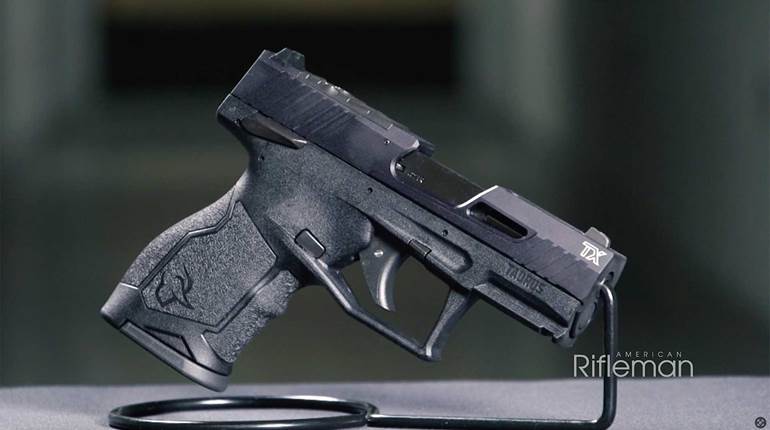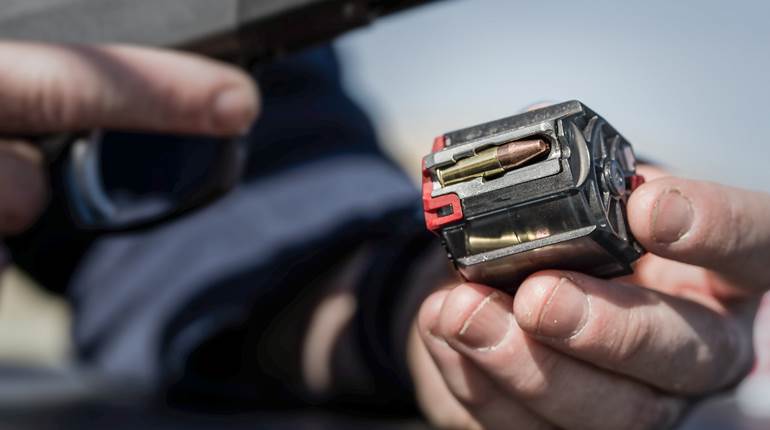John Moses Browning is one of the greatest, if not the greatest, firearm inventor in American history, with many of his designs from over a century ago still in production or carried on through subsequent models. Towards the end of his relationship with Winchester Repeating Arms, Browning improved upon his existing lever-action rifle designs with a new model that had a stronger lock-up for more powerful smokeless centerfire cartridges, which became known as the Model 1895. This design changed the placement of the locking block from the sides of the bolt to the rear, along with the incorporation of an integral box magazine.
 A right-side view of the standard version of the Winchester Model 1895 lever-action rifle, chambered in .405 Win.
A right-side view of the standard version of the Winchester Model 1895 lever-action rifle, chambered in .405 Win.
The design proved a great commercial success and remained popular throughout the 20th century, even as more modern designs were developed. Over a century later, the Model 1895 is still produced by Winchester in partnership with Miroku in Japan. American Rifleman staff had an opportunity to test one of these modern production Model 1895s back in 2020, with the specific model tested chambered in .405 Win. Much like the Model 1895s of old, the current production rifles are made from wood and steel. The steel components, including the receiver and barrel, of the standard model wear a rich and glossy blued finish. Its barrel is 24" long, button rifled with a twist rate of 1:14" right hand twist and giving the rifle an overall length of 42".
 A diagram revealing the inner workings of the Model 1895 action.
A diagram revealing the inner workings of the Model 1895 action.
As for the receiver, it is a classic open-top design, with the bolt riding backwards and ejecting casings out vertically. Due to this, the receiver of the current Model 1895s offered by Winchester is not drilled or tapped for mounting scopes. Rather, it comes with a set of classically styled iron sights, and is drilled and tapped on the side for a side-mounted sight. The irons include a Marble's gold bead front, along with a windage- and elevation-adjustable buckhorn rear. The receiver section does include two differences from the original Model 1895s, with the inclusion of a tang safety tab and a more modern unlocking feature built into the action lever. This more modern lever results in a smoother unlocking and operation of the action.
 Testing the Model 1895 on the range, with the action opened and a spent cartridge ejecting out of the top.
Testing the Model 1895 on the range, with the action opened and a spent cartridge ejecting out of the top.
The magazine is fed through the open top of the action and has a capacity of four rounds. While the standard example tested here is chambered in .405 Win., the Model 1895 is also available in .30-40 Krag and .30-'06 Sprg. with the same magazine capacity and barrel length, albeit with a 1:10' right-hand twist rate for those cartridges. For furniture, the standard version comes with a stock and hand-guard made from Grade I black walnut. The stock has a straight profile without a semi-pistol grip with traditional-cut checkering added at the grip. It has a 13 1/4" length-of-pull along with a 2 7/8" drop at the comb. As for the hand-guard, it is shaped in a Schnabel styling and also has checkering cut in the grip portions.
 A close-up view of the engraved nickel receiver on one of the now discontinued Model 1895 125th Anniversary rifles.
A close-up view of the engraved nickel receiver on one of the now discontinued Model 1895 125th Anniversary rifles.
Alongside the standard model, Winchester currently offers a High Grade version of the rifle. Model 1895 High Grade rifles are largely identical to the standard rifles, aside for more ornate Grade III to IV walnut furniture. Winchester did offer a Model 1895 125th Anniversary version at the time of testing, with an engraved nickel receiver, but it has since been discontinued. To learn more about the Model 1895 lever-action rifles currently offered by Winchester, visit winchesterguns.com.
To watch complete segments of past episodes of American Rifleman TV, go to americanrifleman.org/artv. For all-new episodes of ARTV, tune in Wednesday nights to Outdoor Channel 8:30 p.m. and 11:30 p.m. EST.


























